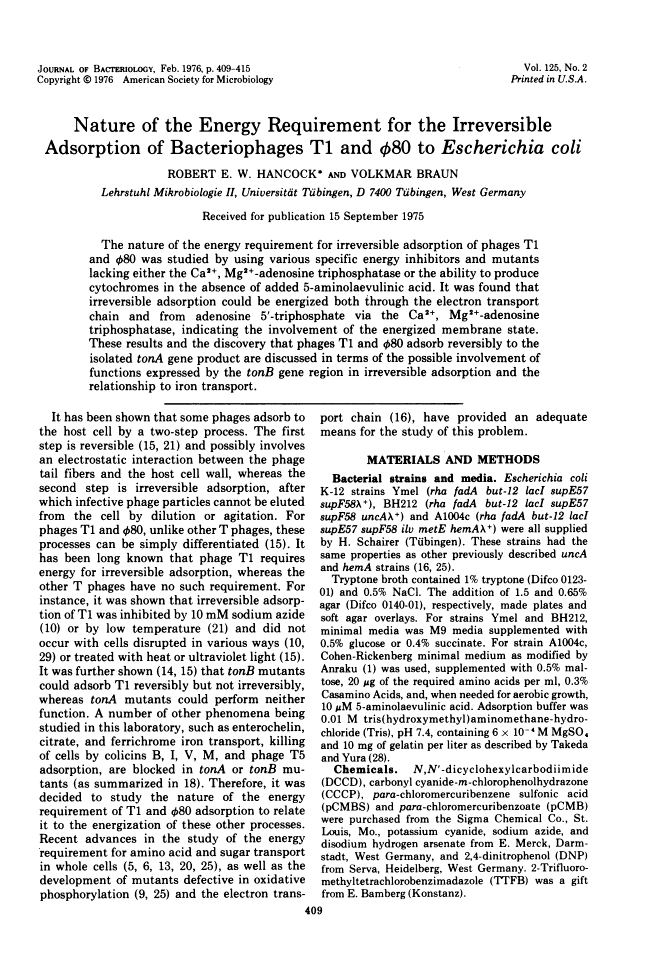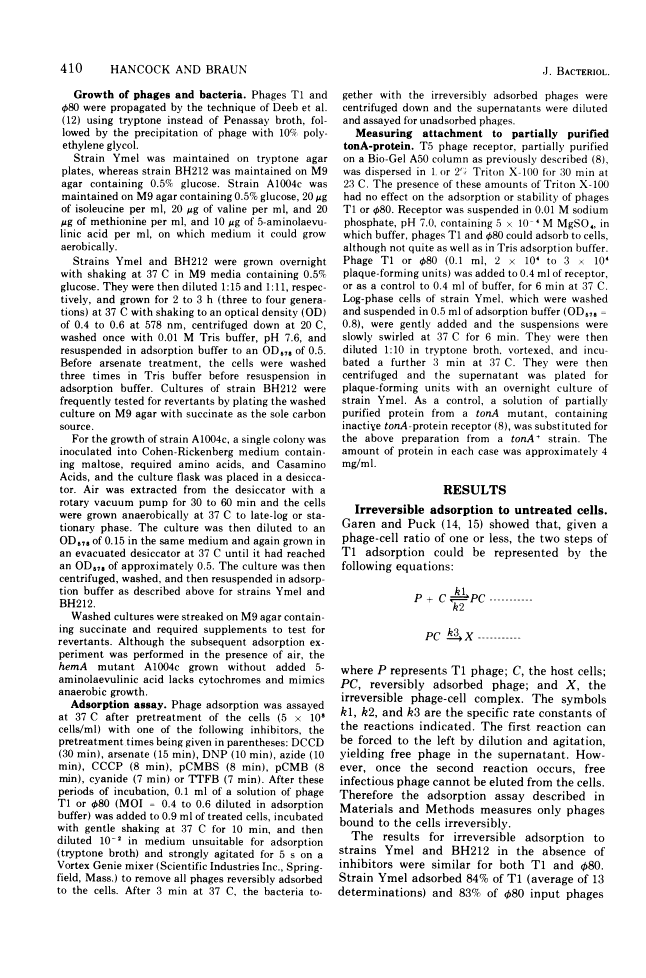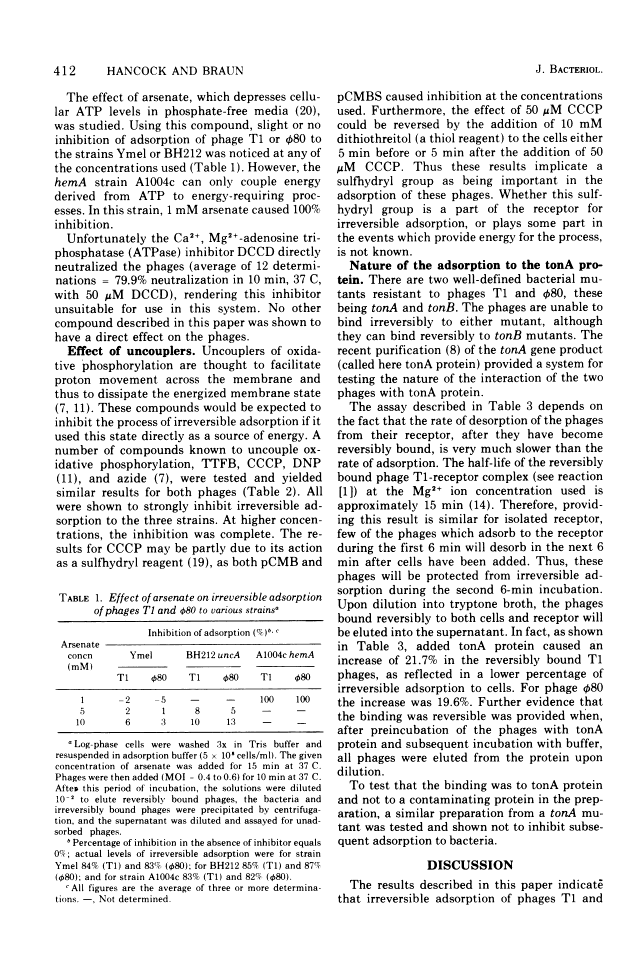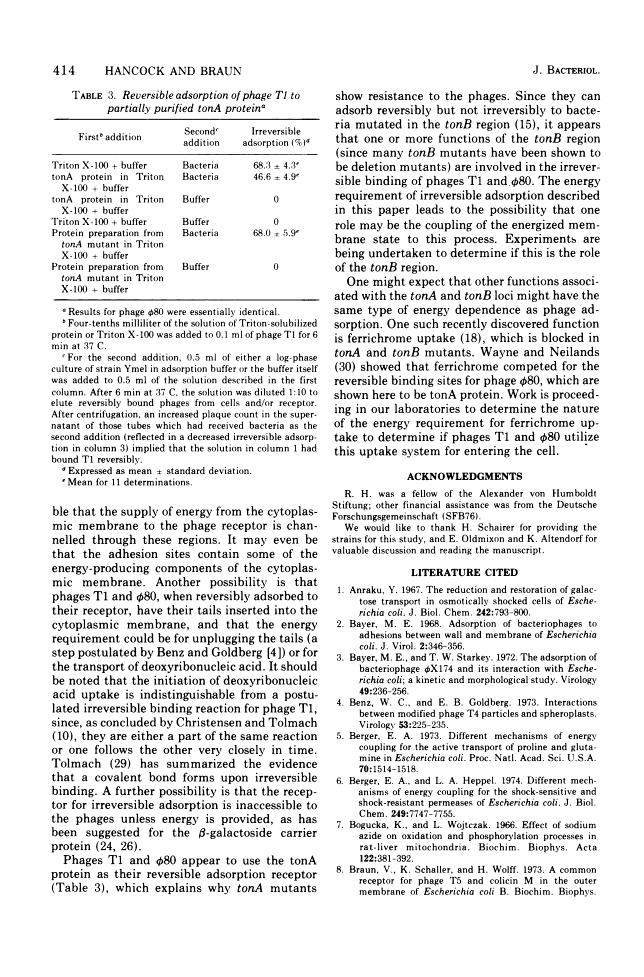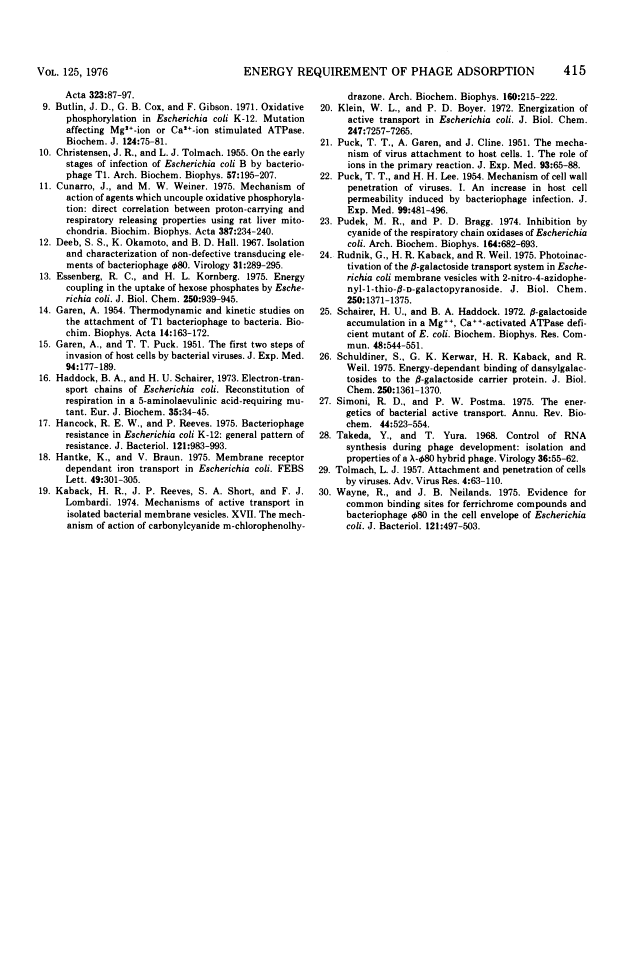Abstract
Free full text

Nature of the energy requirement for the irreversible adsorption of bacteriophages T1 and phi80 to Escherichia coli.
Abstract
The nature of the energy requirement for irreversible adsorption of phages T1 and phi80 was studied by using various specific energy inhibitors and mutants lacking either the Ca2+, Mg2+-adenosine triphosphatase or the ability to produce cytochromes in the absence of added 5-aminolaevulinic acid. It was found that irreversible adsorption could be energized both through the electron transport chain and from adenosine 5'-triphosphate via the Ca2+, Mg2+-adenosine triphosphatase, indicating the involvement of the energized membrane state. These results and the discovery that phages T1 and phi80 adsorb reversibly to the isolated tonA gene product are discussed in terms of the possible involvement of functions expressed by the tonB gene region in irreversible adsorption and the relationship to iron transport.
Full text
Full text is available as a scanned copy of the original print version. Get a printable copy (PDF file) of the complete article (1.0M), or click on a page image below to browse page by page. Links to PubMed are also available for Selected References.
Selected References
These references are in PubMed. This may not be the complete list of references from this article.
- Anraku Y. The reduction and restoration of galactose transport in osmotically shocked cells of Escherichia coli. J Biol Chem. 1967 Mar 10;242(5):793–800. [Abstract] [Google Scholar]
- Bayer ME. Adsorption of bacteriophages to adhesions between wall and membrane of Escherichia coli. J Virol. 1968 Apr;2(4):346–356. [Europe PMC free article] [Abstract] [Google Scholar]
- Bayer ME, Starkey TW. The adsorption of bacteriophage phi X174 and its interaction with Escherichia coli; a kinetic and morphological study. Virology. 1972 Jul;49(1):236–256. [Abstract] [Google Scholar]
- Benz WC, Goldberg EB. Interactions between modified phage T4 particles and spheroplasts. Virology. 1973 May;53(1):225–235. [Abstract] [Google Scholar]
- Berger EA. Different mechanisms of energy coupling for the active transport of proline and glutamine in Escherichia coli. Proc Natl Acad Sci U S A. 1973 May;70(5):1514–1518. [Europe PMC free article] [Abstract] [Google Scholar]
- Berger EA, Heppel LA. Different mechanisms of energy coupling for the shock-sensitive and shock-resistant amino acid permeases of Escherichia coli. J Biol Chem. 1974 Dec 25;249(24):7747–7755. [Abstract] [Google Scholar]
- Butlin JD, Cox GB, Gibson F. Oxidative phosphorylation in Escherichia coli K12. Mutations affecting magnesium ion- or calcium ion-stimulated adenosine triphosphatase. Biochem J. 1971 Aug;124(1):75–81. [Europe PMC free article] [Abstract] [Google Scholar]
- CHRISTENSEN JR, TOLMACH LJ. On the early stages of infection of Escherichia coli B by bacteriophage T1. Arch Biochem Biophys. 1955 Jul;57(1):195–207. [Abstract] [Google Scholar]
- Cunarro J, Weiner MW. Mechanism of action of agents which uncouple oxidative phosphorylation: direct correlation between proton-carrying and respiratory-releasing properties using rat liver mitochondria. Biochim Biophys Acta. 1975 May 15;387(2):234–240. [Abstract] [Google Scholar]
- Deeb SS, Okamoto K, Hall BD. Isolation and characterization of non-defective transducing elements of bacteriophage phi-80. Virology. 1967 Feb;31(2):289–295. [Abstract] [Google Scholar]
- Essenberg RC, Kornberg HL. Energy coupling in the uptake of hexose phosphates by Escherichia coli. J Biol Chem. 1975 Feb 10;250(3):939–945. [Abstract] [Google Scholar]
- GAREN A. Thermodynamic and kinetic studies on the attachment of T1 bacteriophage to bacteria. Biochim Biophys Acta. 1954 Jun;14(2):163–172. [Abstract] [Google Scholar]
- GAREN A, PUCK TT. The first two steps of the invasion of host cells by bacterial viruses. II. J Exp Med. 1951 Sep;94(3):177–189. [Europe PMC free article] [Abstract] [Google Scholar]
- Haddock BA, Schairer HU. Electron-transport chains of Escherichia coli. Reconstitution of respiration in a 5-aminolaevulinic acid-requiring mutant. Eur J Biochem. 1973 May;35(1):34–45. [Abstract] [Google Scholar]
- Hancock RE, Reeves P. Bacteriophage resistance in Escherichia coli K-12: general pattern of resistance. J Bacteriol. 1975 Mar;121(3):983–993. [Europe PMC free article] [Abstract] [Google Scholar]
- Hantke K, Braun V. Membrane receptor dependent iron transport in Escherichia coli. FEBS Lett. 1975 Jan 1;49(3):301–305. [Abstract] [Google Scholar]
- Kaback HR, Reeves JP, Short SA, Lombardi FJ. Mechanisms of active transport in isolated bacterial membrane vesicles. 18. The mechanism of action of carbonylcyanide m-chlorophenylhydrazone. Arch Biochem Biophys. 1974 Jan;160(1):215–222. [Abstract] [Google Scholar]
- Klein WL, Boyer PD. Energization of active transport by Escherichia coli. J Biol Chem. 1972 Nov 25;247(22):7257–7265. [Abstract] [Google Scholar]
- PUCK TT, GAREN A, CLINE J. The mechanism of virus attachment to host cells. I. The role of ions in the primary reaction. J Exp Med. 1951 Jan;93(1):65–88. [Europe PMC free article] [Abstract] [Google Scholar]
- PUCK TT, LEE HH. Mechanism of cell wall penetration by viruses. I. An increase in host cell permeability induced by bacteriophage infection. J Exp Med. 1954 May 1;99(5):481–494. [Europe PMC free article] [Abstract] [Google Scholar]
- Pudek MR, Bragg PD. Inhibition by cyanide of the respiratory chain oxidases of Escherichia coli. Arch Biochem Biophys. 1974 Oct;164(2):682–693. [Abstract] [Google Scholar]
- Rudnick G, Kaback HR, Weil R. Photoinactivation of the beta-galactoside transport system in Escherichia coli membrane vesicles with 2-nitro-4-azidophenyl-1-thio-beta-D-galactopyranoside. J Biol Chem. 1975 Feb 25;250(4):1371–1375. [Abstract] [Google Scholar]
- Schairer HU, Haddock BA. -Galactoside accumulation in a Mg 2+ -,Ca 2+ -activated ATPase deficient mutant of E.coli. Biochem Biophys Res Commun. 1972 Aug 7;48(3):544–551. [Abstract] [Google Scholar]
- Schuldiner S, Kerwar GK, Kaback HR, Weil R. Energy-dependent binding of dansylgalactosides to the beta-galactoside carrier protein. J Biol Chem. 1975 Feb 25;250(4):1361–1370. [Abstract] [Google Scholar]
- Simoni RD, Postma PW. The energetics of bacterial active transport. Annu Rev Biochem. 1975;44:523–554. [Abstract] [Google Scholar]
- Takeda Y, Yura T. Control of RNA synthesis during phage development: isolation and properties of a lambda-phi81 hybrid phage. Virology. 1968 Sep;36(1):55–62. [Abstract] [Google Scholar]
- TOLMACH LJ. Attachment and penetration of cells by viruses. Adv Virus Res. 1957;4:63–110. [Abstract] [Google Scholar]
- Wayne R, Neilands JB. Evidence for common binding sites for ferrichrome compounds and bacteriophage phi 80 in the cell envelope of Escherichia coli. J Bacteriol. 1975 Feb;121(2):497–503. [Europe PMC free article] [Abstract] [Google Scholar]
Associated Data
Articles from Journal of Bacteriology are provided here courtesy of American Society for Microbiology (ASM)
Full text links
Read article at publisher's site: https://doi.org/10.1128/jb.125.2.409-415.1976
Read article for free, from open access legal sources, via Unpaywall:
https://jb.asm.org/content/jb/125/2/409.full.pdf
Free to read at jb.asm.org
http://jb.asm.org/cgi/content/abstract/125/2/409
Free after 4 months at jb.asm.org
http://jb.asm.org/cgi/reprint/125/2/409
Citations & impact
Impact metrics
Citations of article over time
Alternative metrics

Discover the attention surrounding your research
https://www.altmetric.com/details/159520858
Smart citations by scite.ai
Explore citation contexts and check if this article has been
supported or disputed.
https://scite.ai/reports/10.1128/jb.125.2.409-415.1976
Article citations
The TolC and Lipopolysaccharide-Specific <i>Escherichia coli</i> Bacteriophage TLS-the <i>Tlsvirus</i> Archetype Virus.
Phage (New Rochelle), 5(3):173-183, 16 Sep 2024
Cited by: 0 articles | PMID: 39372356
Energization of Outer Membrane Transport by the ExbB ExbD Molecular Motor.
J Bacteriol, 205(6):e0003523, 23 May 2023
Cited by: 6 articles | PMID: 37219427 | PMCID: PMC10294619
Review Free full text in Europe PMC
Characterization of the Attachment of Three New Coliphages onto the Ferrichrome Transporter FhuA.
J Virol, 97(7):e0066723, 13 Jun 2023
Cited by: 1 article | PMID: 37310294 | PMCID: PMC10373560
Ribitol-Containing Wall Teichoic Acid of Tetragenococcus halophilus Is Targeted by Bacteriophage phiWJ7 as a Binding Receptor.
Microbiol Spectr, 10(2):e0033622, 21 Mar 2022
Cited by: 5 articles | PMID: 35311554 | PMCID: PMC9045211
Functional Diversity of TonB-Like Proteins in the Heterocyst-Forming Cyanobacterium Anabaena sp. PCC 7120.
mSphere, 6(6):e0021421, 17 Nov 2021
Cited by: 4 articles | PMID: 34787445 | PMCID: PMC8597729
Go to all (150) article citations
Data
Similar Articles
To arrive at the top five similar articles we use a word-weighted algorithm to compare words from the Title and Abstract of each citation.
Functional interaction of the tonA/tonB receptor system in Escherichia coli.
J Bacteriol, 135(1):190-197, 01 Jul 1978
Cited by: 100 articles | PMID: 353030 | PMCID: PMC224805
Energy coupling for methionine transport in Escherichia coli.
J Bacteriol, 123(3):985-991, 01 Sep 1975
Cited by: 19 articles | PMID: 125747 | PMCID: PMC235823
Transport of sugars and amino acids in bacteria. X. Sources of energy and energy coupling reactions of the active transport systems for isoleucine and proline in E. coli.
J Biochem, 76(2):251-261, 01 Aug 1974
Cited by: 20 articles | PMID: 4154322
Bacterial respiration.
Bacteriol Rev, 41(1):47-99, 01 Mar 1977
Cited by: 212 articles | PMID: 140652 | PMCID: PMC413996
Review Free full text in Europe PMC
